International Tourism System: Hungary and Queensland Analysis Report
VerifiedAdded on 2021/06/18
|11
|2601
|86
Report
AI Summary
This report provides a comprehensive analysis of the international tourism system, focusing on the impacts of tourism in two distinct locations: Hungary (Budapest and Lake Balaton) and Queensland, Australia. The report synthesizes findings from various research papers and articles, examining the environmental, economic, and socio-cultural effects of tourism in each region. In Hungary, the report highlights the economic benefits of tourism, such as improved financial conditions for residents, while also addressing negative impacts like environmental degradation, crime rates, and infrastructure challenges. In Queensland, the report explores the effects of tourism on the environment of Fraser Island, examining the impact on dune lakes and the implementation of environmental management strategies. The report also considers the economic and social impacts of tourism in Northern Queensland, including the role of tourism routes and the analysis of tourism data and statistics. The report concludes by emphasizing the importance of sustainable tourism practices and the need for government intervention to mitigate environmental and social issues while maximizing economic benefits.
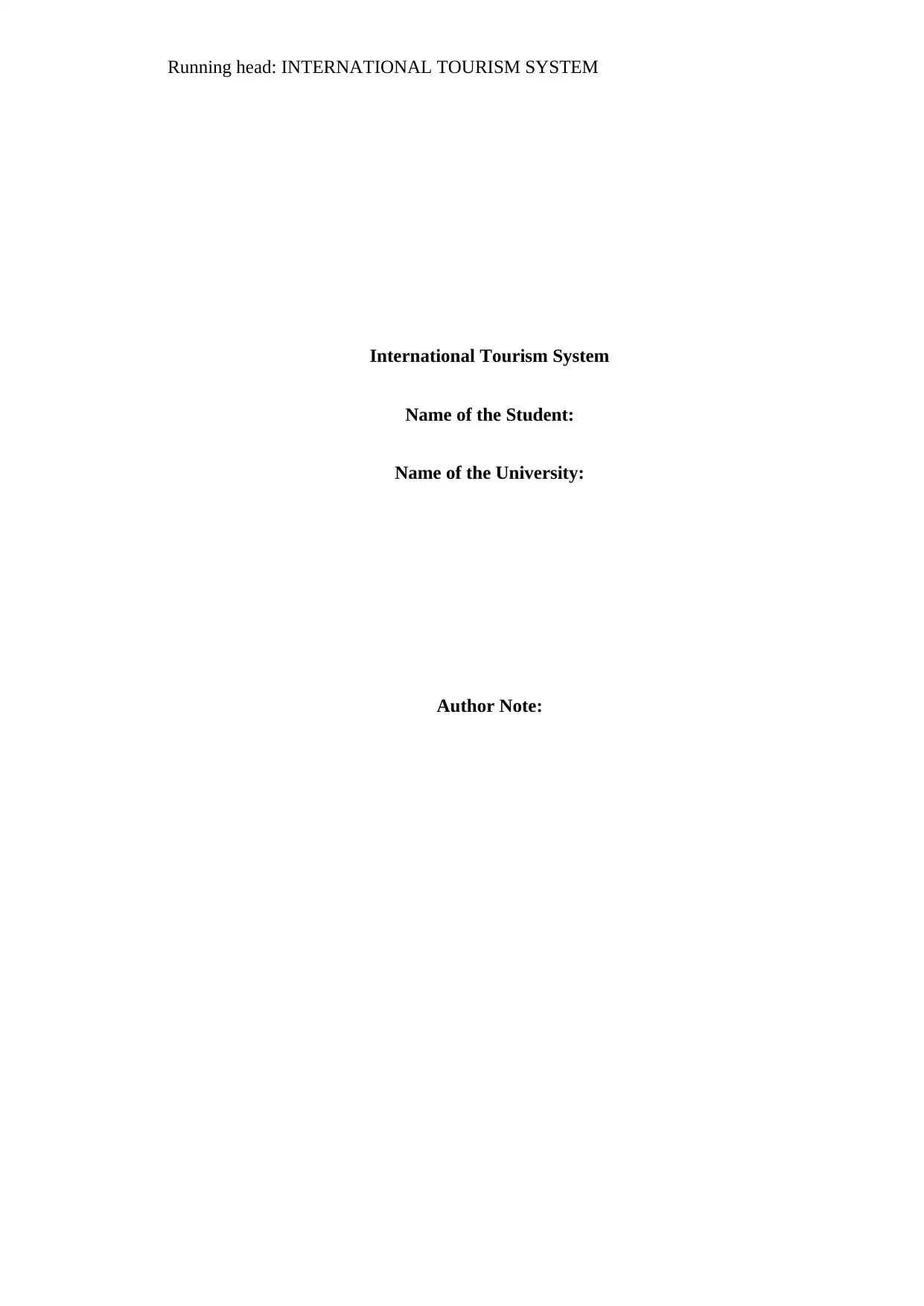
Running head: INTERNATIONAL TOURISM SYSTEM
International Tourism System
Name of the Student:
Name of the University:
Author Note:
International Tourism System
Name of the Student:
Name of the University:
Author Note:
Paraphrase This Document
Need a fresh take? Get an instant paraphrase of this document with our AI Paraphraser
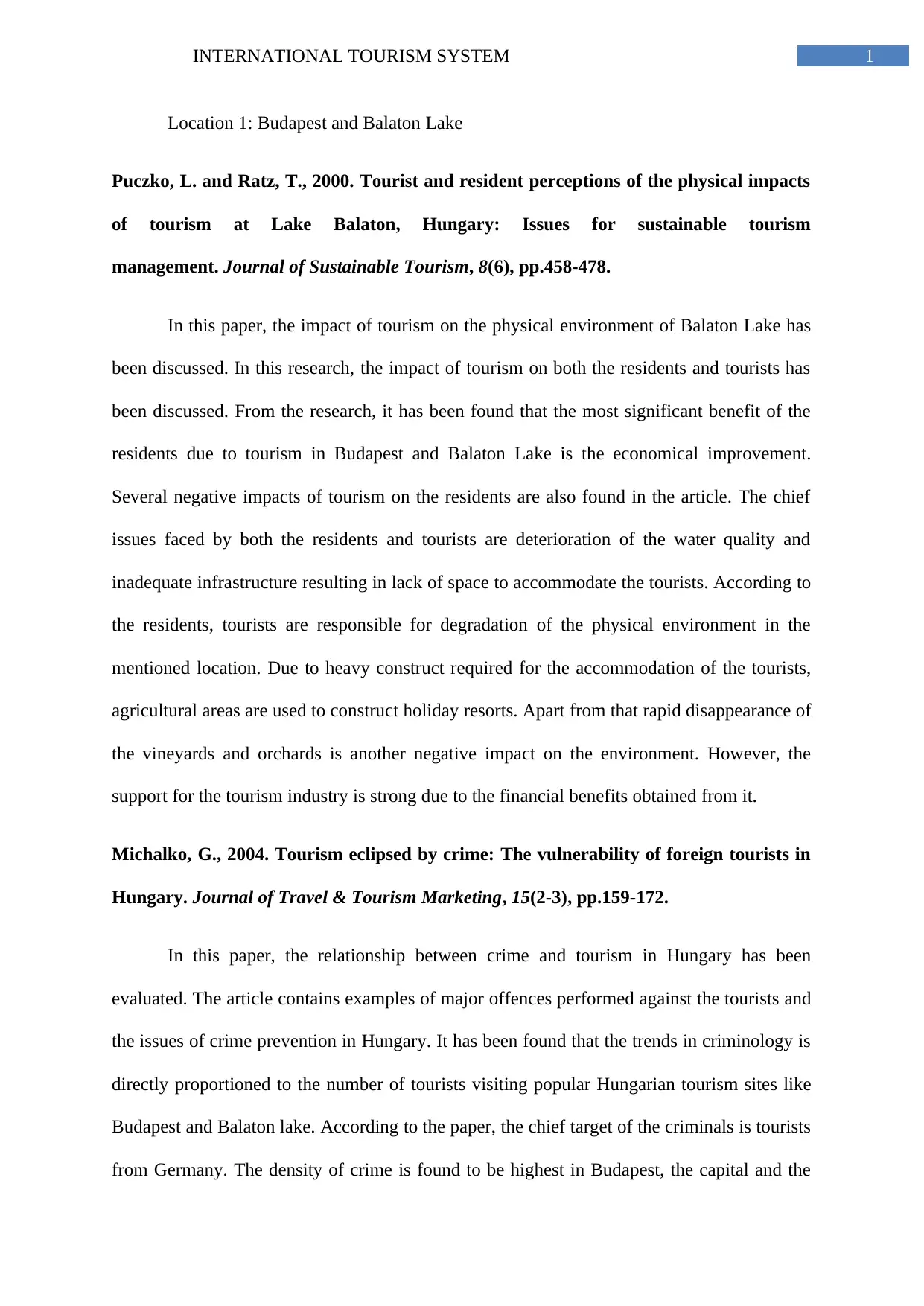
1INTERNATIONAL TOURISM SYSTEM
Location 1: Budapest and Balaton Lake
Puczko, L. and Ratz, T., 2000. Tourist and resident perceptions of the physical impacts
of tourism at Lake Balaton, Hungary: Issues for sustainable tourism
management. Journal of Sustainable Tourism, 8(6), pp.458-478.
In this paper, the impact of tourism on the physical environment of Balaton Lake has
been discussed. In this research, the impact of tourism on both the residents and tourists has
been discussed. From the research, it has been found that the most significant benefit of the
residents due to tourism in Budapest and Balaton Lake is the economical improvement.
Several negative impacts of tourism on the residents are also found in the article. The chief
issues faced by both the residents and tourists are deterioration of the water quality and
inadequate infrastructure resulting in lack of space to accommodate the tourists. According to
the residents, tourists are responsible for degradation of the physical environment in the
mentioned location. Due to heavy construct required for the accommodation of the tourists,
agricultural areas are used to construct holiday resorts. Apart from that rapid disappearance of
the vineyards and orchards is another negative impact on the environment. However, the
support for the tourism industry is strong due to the financial benefits obtained from it.
Michalko, G., 2004. Tourism eclipsed by crime: The vulnerability of foreign tourists in
Hungary. Journal of Travel & Tourism Marketing, 15(2-3), pp.159-172.
In this paper, the relationship between crime and tourism in Hungary has been
evaluated. The article contains examples of major offences performed against the tourists and
the issues of crime prevention in Hungary. It has been found that the trends in criminology is
directly proportioned to the number of tourists visiting popular Hungarian tourism sites like
Budapest and Balaton lake. According to the paper, the chief target of the criminals is tourists
from Germany. The density of crime is found to be highest in Budapest, the capital and the
Location 1: Budapest and Balaton Lake
Puczko, L. and Ratz, T., 2000. Tourist and resident perceptions of the physical impacts
of tourism at Lake Balaton, Hungary: Issues for sustainable tourism
management. Journal of Sustainable Tourism, 8(6), pp.458-478.
In this paper, the impact of tourism on the physical environment of Balaton Lake has
been discussed. In this research, the impact of tourism on both the residents and tourists has
been discussed. From the research, it has been found that the most significant benefit of the
residents due to tourism in Budapest and Balaton Lake is the economical improvement.
Several negative impacts of tourism on the residents are also found in the article. The chief
issues faced by both the residents and tourists are deterioration of the water quality and
inadequate infrastructure resulting in lack of space to accommodate the tourists. According to
the residents, tourists are responsible for degradation of the physical environment in the
mentioned location. Due to heavy construct required for the accommodation of the tourists,
agricultural areas are used to construct holiday resorts. Apart from that rapid disappearance of
the vineyards and orchards is another negative impact on the environment. However, the
support for the tourism industry is strong due to the financial benefits obtained from it.
Michalko, G., 2004. Tourism eclipsed by crime: The vulnerability of foreign tourists in
Hungary. Journal of Travel & Tourism Marketing, 15(2-3), pp.159-172.
In this paper, the relationship between crime and tourism in Hungary has been
evaluated. The article contains examples of major offences performed against the tourists and
the issues of crime prevention in Hungary. It has been found that the trends in criminology is
directly proportioned to the number of tourists visiting popular Hungarian tourism sites like
Budapest and Balaton lake. According to the paper, the chief target of the criminals is tourists
from Germany. The density of crime is found to be highest in Budapest, the capital and the
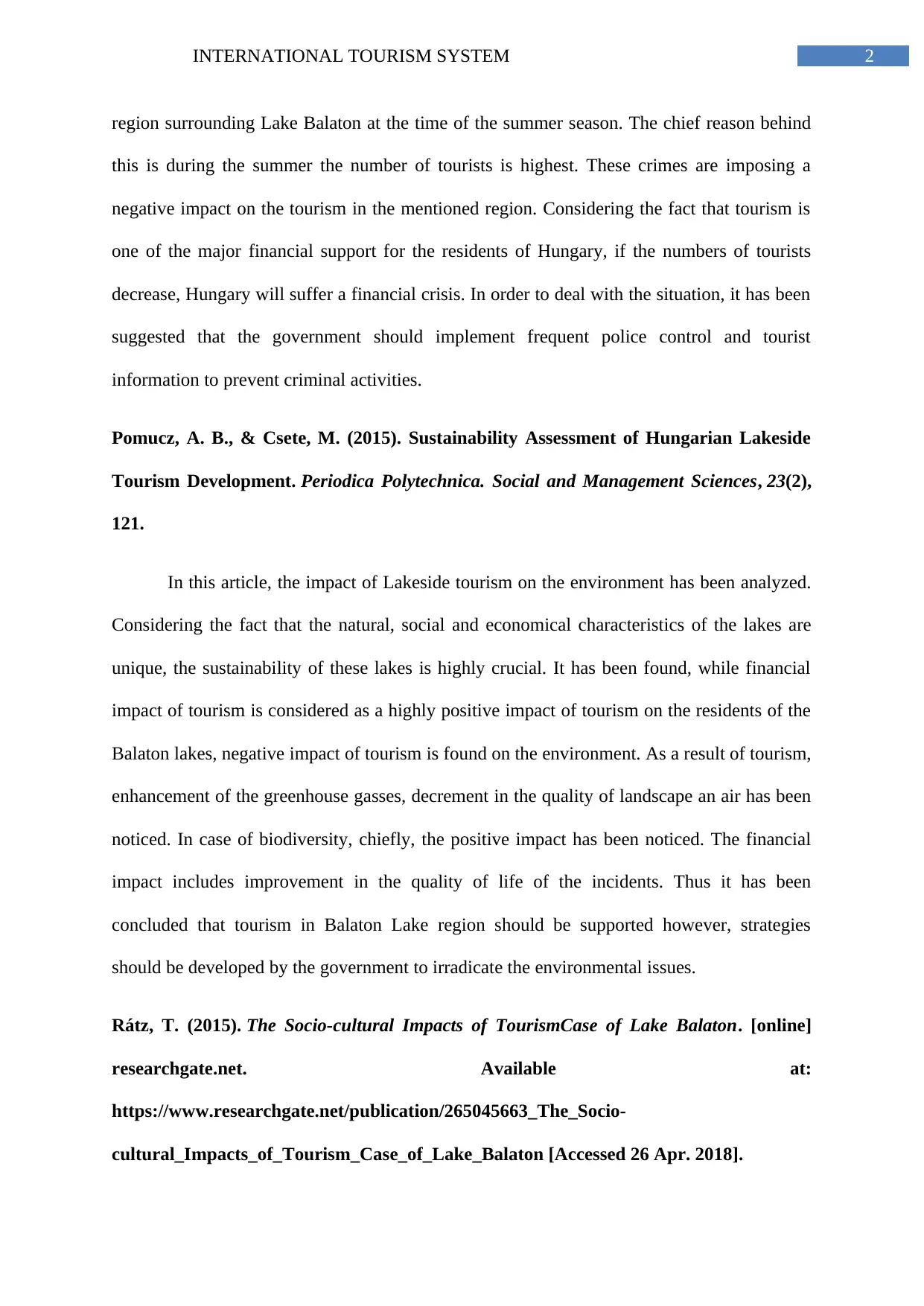
2INTERNATIONAL TOURISM SYSTEM
region surrounding Lake Balaton at the time of the summer season. The chief reason behind
this is during the summer the number of tourists is highest. These crimes are imposing a
negative impact on the tourism in the mentioned region. Considering the fact that tourism is
one of the major financial support for the residents of Hungary, if the numbers of tourists
decrease, Hungary will suffer a financial crisis. In order to deal with the situation, it has been
suggested that the government should implement frequent police control and tourist
information to prevent criminal activities.
Pomucz, A. B., & Csete, M. (2015). Sustainability Assessment of Hungarian Lakeside
Tourism Development. Periodica Polytechnica. Social and Management Sciences, 23(2),
121.
In this article, the impact of Lakeside tourism on the environment has been analyzed.
Considering the fact that the natural, social and economical characteristics of the lakes are
unique, the sustainability of these lakes is highly crucial. It has been found, while financial
impact of tourism is considered as a highly positive impact of tourism on the residents of the
Balaton lakes, negative impact of tourism is found on the environment. As a result of tourism,
enhancement of the greenhouse gasses, decrement in the quality of landscape an air has been
noticed. In case of biodiversity, chiefly, the positive impact has been noticed. The financial
impact includes improvement in the quality of life of the incidents. Thus it has been
concluded that tourism in Balaton Lake region should be supported however, strategies
should be developed by the government to irradicate the environmental issues.
Rátz, T. (2015). The Socio-cultural Impacts of TourismCase of Lake Balaton. [online]
researchgate.net. Available at:
https://www.researchgate.net/publication/265045663_The_Socio-
cultural_Impacts_of_Tourism_Case_of_Lake_Balaton [Accessed 26 Apr. 2018].
region surrounding Lake Balaton at the time of the summer season. The chief reason behind
this is during the summer the number of tourists is highest. These crimes are imposing a
negative impact on the tourism in the mentioned region. Considering the fact that tourism is
one of the major financial support for the residents of Hungary, if the numbers of tourists
decrease, Hungary will suffer a financial crisis. In order to deal with the situation, it has been
suggested that the government should implement frequent police control and tourist
information to prevent criminal activities.
Pomucz, A. B., & Csete, M. (2015). Sustainability Assessment of Hungarian Lakeside
Tourism Development. Periodica Polytechnica. Social and Management Sciences, 23(2),
121.
In this article, the impact of Lakeside tourism on the environment has been analyzed.
Considering the fact that the natural, social and economical characteristics of the lakes are
unique, the sustainability of these lakes is highly crucial. It has been found, while financial
impact of tourism is considered as a highly positive impact of tourism on the residents of the
Balaton lakes, negative impact of tourism is found on the environment. As a result of tourism,
enhancement of the greenhouse gasses, decrement in the quality of landscape an air has been
noticed. In case of biodiversity, chiefly, the positive impact has been noticed. The financial
impact includes improvement in the quality of life of the incidents. Thus it has been
concluded that tourism in Balaton Lake region should be supported however, strategies
should be developed by the government to irradicate the environmental issues.
Rátz, T. (2015). The Socio-cultural Impacts of TourismCase of Lake Balaton. [online]
researchgate.net. Available at:
https://www.researchgate.net/publication/265045663_The_Socio-
cultural_Impacts_of_Tourism_Case_of_Lake_Balaton [Accessed 26 Apr. 2018].
⊘ This is a preview!⊘
Do you want full access?
Subscribe today to unlock all pages.

Trusted by 1+ million students worldwide
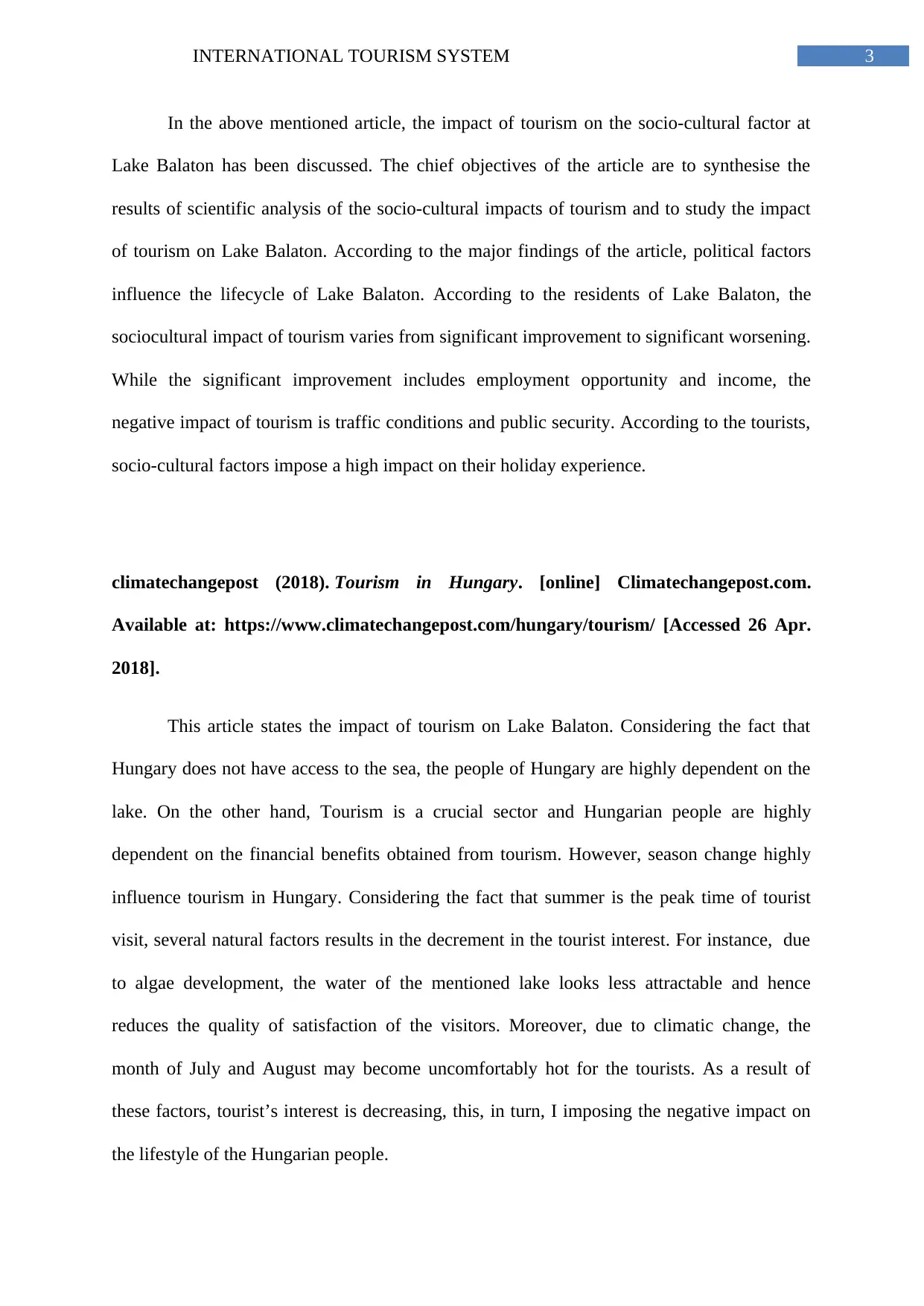
3INTERNATIONAL TOURISM SYSTEM
In the above mentioned article, the impact of tourism on the socio-cultural factor at
Lake Balaton has been discussed. The chief objectives of the article are to synthesise the
results of scientific analysis of the socio-cultural impacts of tourism and to study the impact
of tourism on Lake Balaton. According to the major findings of the article, political factors
influence the lifecycle of Lake Balaton. According to the residents of Lake Balaton, the
sociocultural impact of tourism varies from significant improvement to significant worsening.
While the significant improvement includes employment opportunity and income, the
negative impact of tourism is traffic conditions and public security. According to the tourists,
socio-cultural factors impose a high impact on their holiday experience.
climatechangepost (2018). Tourism in Hungary. [online] Climatechangepost.com.
Available at: https://www.climatechangepost.com/hungary/tourism/ [Accessed 26 Apr.
2018].
This article states the impact of tourism on Lake Balaton. Considering the fact that
Hungary does not have access to the sea, the people of Hungary are highly dependent on the
lake. On the other hand, Tourism is a crucial sector and Hungarian people are highly
dependent on the financial benefits obtained from tourism. However, season change highly
influence tourism in Hungary. Considering the fact that summer is the peak time of tourist
visit, several natural factors results in the decrement in the tourist interest. For instance, due
to algae development, the water of the mentioned lake looks less attractable and hence
reduces the quality of satisfaction of the visitors. Moreover, due to climatic change, the
month of July and August may become uncomfortably hot for the tourists. As a result of
these factors, tourist’s interest is decreasing, this, in turn, I imposing the negative impact on
the lifestyle of the Hungarian people.
In the above mentioned article, the impact of tourism on the socio-cultural factor at
Lake Balaton has been discussed. The chief objectives of the article are to synthesise the
results of scientific analysis of the socio-cultural impacts of tourism and to study the impact
of tourism on Lake Balaton. According to the major findings of the article, political factors
influence the lifecycle of Lake Balaton. According to the residents of Lake Balaton, the
sociocultural impact of tourism varies from significant improvement to significant worsening.
While the significant improvement includes employment opportunity and income, the
negative impact of tourism is traffic conditions and public security. According to the tourists,
socio-cultural factors impose a high impact on their holiday experience.
climatechangepost (2018). Tourism in Hungary. [online] Climatechangepost.com.
Available at: https://www.climatechangepost.com/hungary/tourism/ [Accessed 26 Apr.
2018].
This article states the impact of tourism on Lake Balaton. Considering the fact that
Hungary does not have access to the sea, the people of Hungary are highly dependent on the
lake. On the other hand, Tourism is a crucial sector and Hungarian people are highly
dependent on the financial benefits obtained from tourism. However, season change highly
influence tourism in Hungary. Considering the fact that summer is the peak time of tourist
visit, several natural factors results in the decrement in the tourist interest. For instance, due
to algae development, the water of the mentioned lake looks less attractable and hence
reduces the quality of satisfaction of the visitors. Moreover, due to climatic change, the
month of July and August may become uncomfortably hot for the tourists. As a result of
these factors, tourist’s interest is decreasing, this, in turn, I imposing the negative impact on
the lifestyle of the Hungarian people.
Paraphrase This Document
Need a fresh take? Get an instant paraphrase of this document with our AI Paraphraser
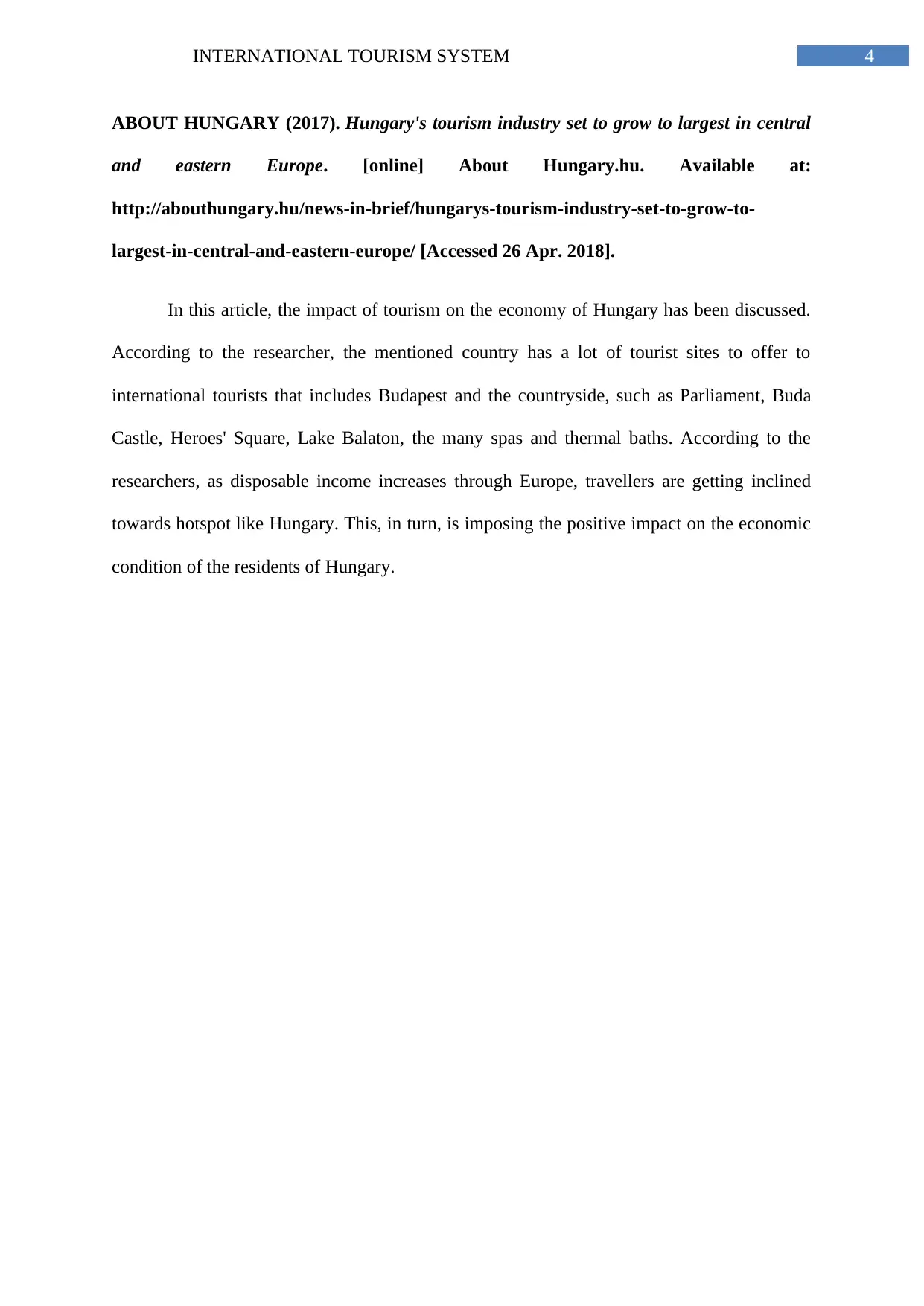
4INTERNATIONAL TOURISM SYSTEM
ABOUT HUNGARY (2017). Hungary's tourism industry set to grow to largest in central
and eastern Europe. [online] About Hungary.hu. Available at:
http://abouthungary.hu/news-in-brief/hungarys-tourism-industry-set-to-grow-to-
largest-in-central-and-eastern-europe/ [Accessed 26 Apr. 2018].
In this article, the impact of tourism on the economy of Hungary has been discussed.
According to the researcher, the mentioned country has a lot of tourist sites to offer to
international tourists that includes Budapest and the countryside, such as Parliament, Buda
Castle, Heroes' Square, Lake Balaton, the many spas and thermal baths. According to the
researchers, as disposable income increases through Europe, travellers are getting inclined
towards hotspot like Hungary. This, in turn, is imposing the positive impact on the economic
condition of the residents of Hungary.
ABOUT HUNGARY (2017). Hungary's tourism industry set to grow to largest in central
and eastern Europe. [online] About Hungary.hu. Available at:
http://abouthungary.hu/news-in-brief/hungarys-tourism-industry-set-to-grow-to-
largest-in-central-and-eastern-europe/ [Accessed 26 Apr. 2018].
In this article, the impact of tourism on the economy of Hungary has been discussed.
According to the researcher, the mentioned country has a lot of tourist sites to offer to
international tourists that includes Budapest and the countryside, such as Parliament, Buda
Castle, Heroes' Square, Lake Balaton, the many spas and thermal baths. According to the
researchers, as disposable income increases through Europe, travellers are getting inclined
towards hotspot like Hungary. This, in turn, is imposing the positive impact on the economic
condition of the residents of Hungary.
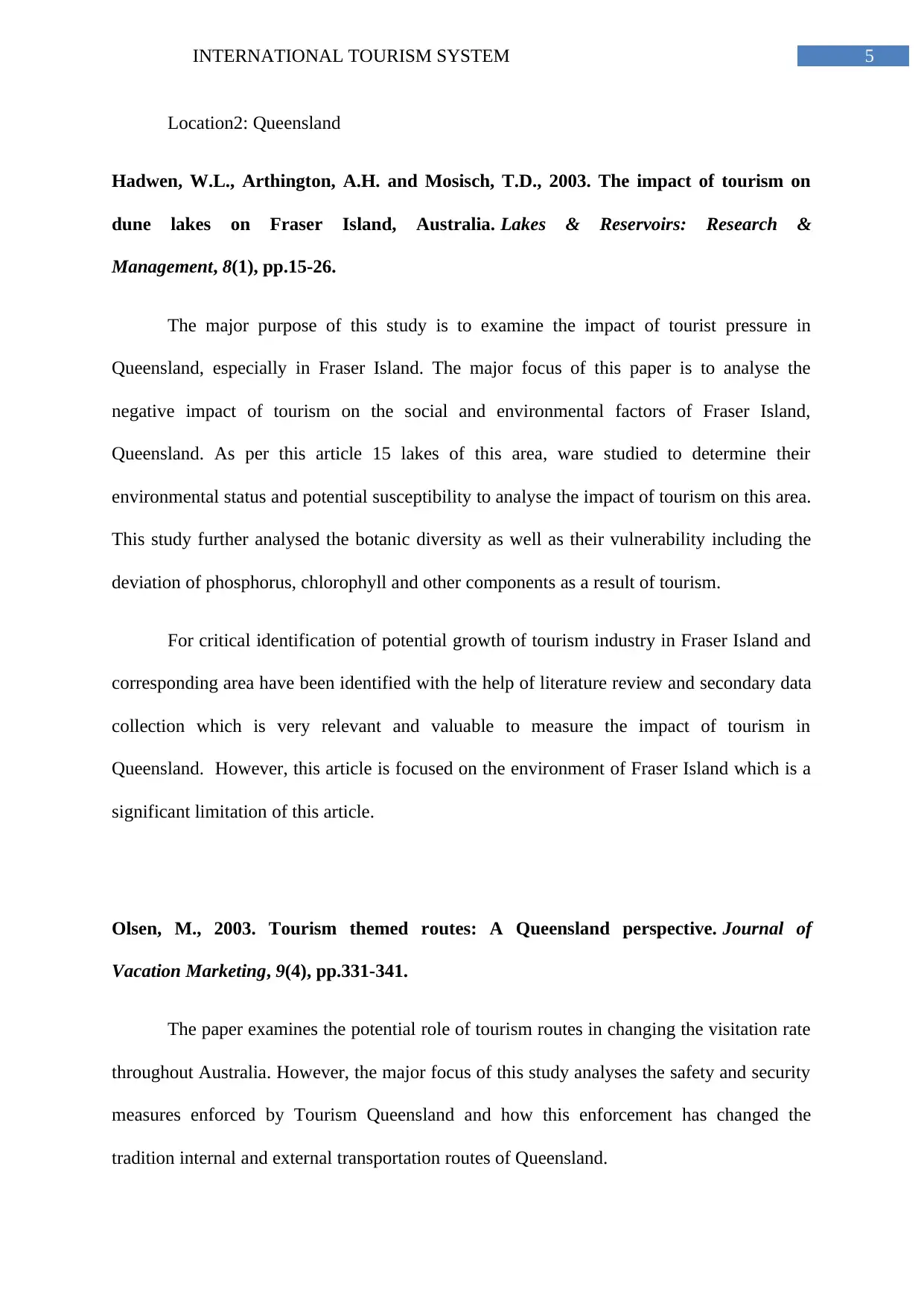
5INTERNATIONAL TOURISM SYSTEM
Location2: Queensland
Hadwen, W.L., Arthington, A.H. and Mosisch, T.D., 2003. The impact of tourism on
dune lakes on Fraser Island, Australia. Lakes & Reservoirs: Research &
Management, 8(1), pp.15-26.
The major purpose of this study is to examine the impact of tourist pressure in
Queensland, especially in Fraser Island. The major focus of this paper is to analyse the
negative impact of tourism on the social and environmental factors of Fraser Island,
Queensland. As per this article 15 lakes of this area, ware studied to determine their
environmental status and potential susceptibility to analyse the impact of tourism on this area.
This study further analysed the botanic diversity as well as their vulnerability including the
deviation of phosphorus, chlorophyll and other components as a result of tourism.
For critical identification of potential growth of tourism industry in Fraser Island and
corresponding area have been identified with the help of literature review and secondary data
collection which is very relevant and valuable to measure the impact of tourism in
Queensland. However, this article is focused on the environment of Fraser Island which is a
significant limitation of this article.
Olsen, M., 2003. Tourism themed routes: A Queensland perspective. Journal of
Vacation Marketing, 9(4), pp.331-341.
The paper examines the potential role of tourism routes in changing the visitation rate
throughout Australia. However, the major focus of this study analyses the safety and security
measures enforced by Tourism Queensland and how this enforcement has changed the
tradition internal and external transportation routes of Queensland.
Location2: Queensland
Hadwen, W.L., Arthington, A.H. and Mosisch, T.D., 2003. The impact of tourism on
dune lakes on Fraser Island, Australia. Lakes & Reservoirs: Research &
Management, 8(1), pp.15-26.
The major purpose of this study is to examine the impact of tourist pressure in
Queensland, especially in Fraser Island. The major focus of this paper is to analyse the
negative impact of tourism on the social and environmental factors of Fraser Island,
Queensland. As per this article 15 lakes of this area, ware studied to determine their
environmental status and potential susceptibility to analyse the impact of tourism on this area.
This study further analysed the botanic diversity as well as their vulnerability including the
deviation of phosphorus, chlorophyll and other components as a result of tourism.
For critical identification of potential growth of tourism industry in Fraser Island and
corresponding area have been identified with the help of literature review and secondary data
collection which is very relevant and valuable to measure the impact of tourism in
Queensland. However, this article is focused on the environment of Fraser Island which is a
significant limitation of this article.
Olsen, M., 2003. Tourism themed routes: A Queensland perspective. Journal of
Vacation Marketing, 9(4), pp.331-341.
The paper examines the potential role of tourism routes in changing the visitation rate
throughout Australia. However, the major focus of this study analyses the safety and security
measures enforced by Tourism Queensland and how this enforcement has changed the
tradition internal and external transportation routes of Queensland.
⊘ This is a preview!⊘
Do you want full access?
Subscribe today to unlock all pages.

Trusted by 1+ million students worldwide
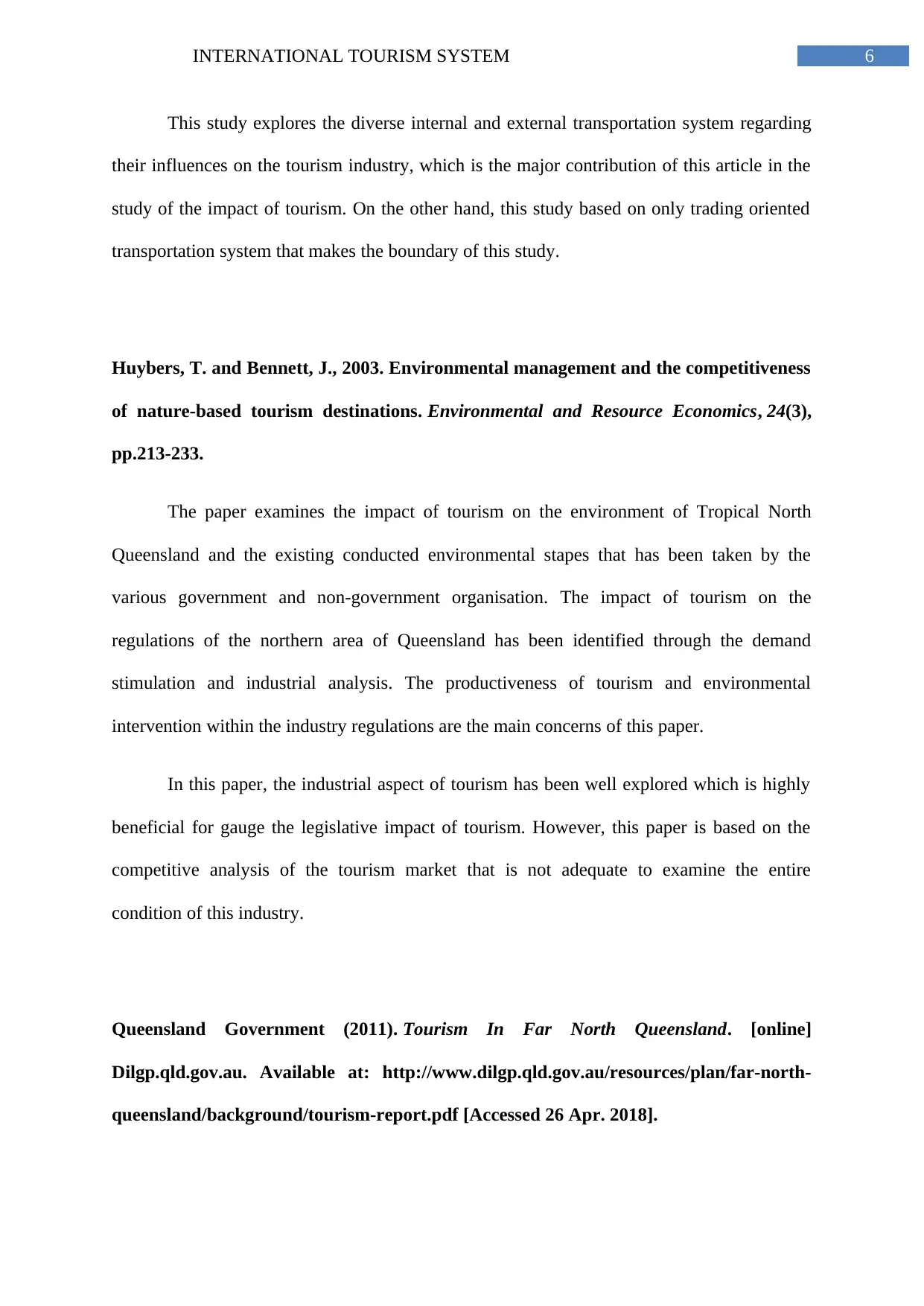
6INTERNATIONAL TOURISM SYSTEM
This study explores the diverse internal and external transportation system regarding
their influences on the tourism industry, which is the major contribution of this article in the
study of the impact of tourism. On the other hand, this study based on only trading oriented
transportation system that makes the boundary of this study.
Huybers, T. and Bennett, J., 2003. Environmental management and the competitiveness
of nature-based tourism destinations. Environmental and Resource Economics, 24(3),
pp.213-233.
The paper examines the impact of tourism on the environment of Tropical North
Queensland and the existing conducted environmental stapes that has been taken by the
various government and non-government organisation. The impact of tourism on the
regulations of the northern area of Queensland has been identified through the demand
stimulation and industrial analysis. The productiveness of tourism and environmental
intervention within the industry regulations are the main concerns of this paper.
In this paper, the industrial aspect of tourism has been well explored which is highly
beneficial for gauge the legislative impact of tourism. However, this paper is based on the
competitive analysis of the tourism market that is not adequate to examine the entire
condition of this industry.
Queensland Government (2011). Tourism In Far North Queensland. [online]
Dilgp.qld.gov.au. Available at: http://www.dilgp.qld.gov.au/resources/plan/far-north-
queensland/background/tourism-report.pdf [Accessed 26 Apr. 2018].
This study explores the diverse internal and external transportation system regarding
their influences on the tourism industry, which is the major contribution of this article in the
study of the impact of tourism. On the other hand, this study based on only trading oriented
transportation system that makes the boundary of this study.
Huybers, T. and Bennett, J., 2003. Environmental management and the competitiveness
of nature-based tourism destinations. Environmental and Resource Economics, 24(3),
pp.213-233.
The paper examines the impact of tourism on the environment of Tropical North
Queensland and the existing conducted environmental stapes that has been taken by the
various government and non-government organisation. The impact of tourism on the
regulations of the northern area of Queensland has been identified through the demand
stimulation and industrial analysis. The productiveness of tourism and environmental
intervention within the industry regulations are the main concerns of this paper.
In this paper, the industrial aspect of tourism has been well explored which is highly
beneficial for gauge the legislative impact of tourism. However, this paper is based on the
competitive analysis of the tourism market that is not adequate to examine the entire
condition of this industry.
Queensland Government (2011). Tourism In Far North Queensland. [online]
Dilgp.qld.gov.au. Available at: http://www.dilgp.qld.gov.au/resources/plan/far-north-
queensland/background/tourism-report.pdf [Accessed 26 Apr. 2018].
Paraphrase This Document
Need a fresh take? Get an instant paraphrase of this document with our AI Paraphraser
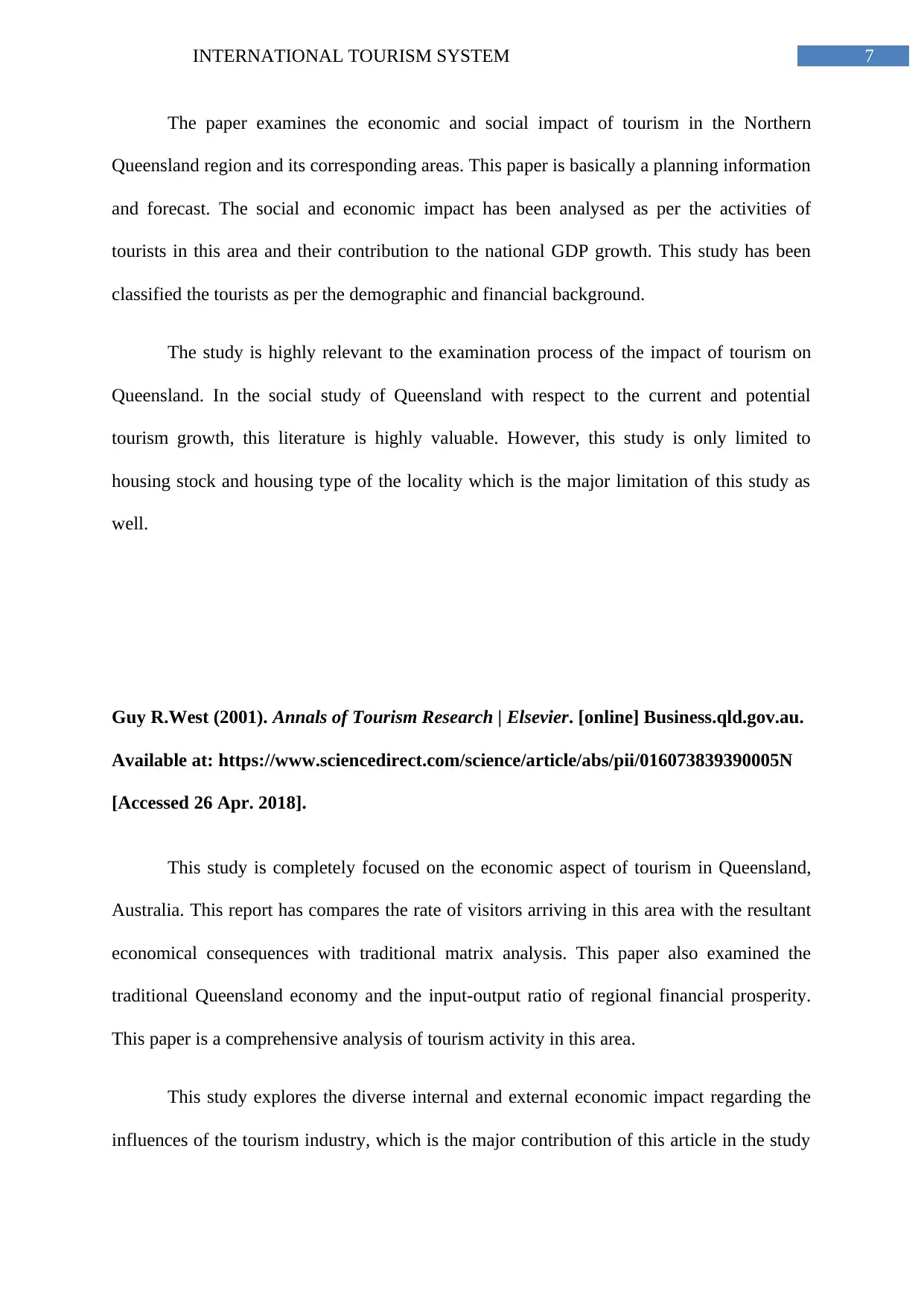
7INTERNATIONAL TOURISM SYSTEM
The paper examines the economic and social impact of tourism in the Northern
Queensland region and its corresponding areas. This paper is basically a planning information
and forecast. The social and economic impact has been analysed as per the activities of
tourists in this area and their contribution to the national GDP growth. This study has been
classified the tourists as per the demographic and financial background.
The study is highly relevant to the examination process of the impact of tourism on
Queensland. In the social study of Queensland with respect to the current and potential
tourism growth, this literature is highly valuable. However, this study is only limited to
housing stock and housing type of the locality which is the major limitation of this study as
well.
Guy R.West (2001). Annals of Tourism Research | Elsevier. [online] Business.qld.gov.au.
Available at: https://www.sciencedirect.com/science/article/abs/pii/016073839390005N
[Accessed 26 Apr. 2018].
This study is completely focused on the economic aspect of tourism in Queensland,
Australia. This report has compares the rate of visitors arriving in this area with the resultant
economical consequences with traditional matrix analysis. This paper also examined the
traditional Queensland economy and the input-output ratio of regional financial prosperity.
This paper is a comprehensive analysis of tourism activity in this area.
This study explores the diverse internal and external economic impact regarding the
influences of the tourism industry, which is the major contribution of this article in the study
The paper examines the economic and social impact of tourism in the Northern
Queensland region and its corresponding areas. This paper is basically a planning information
and forecast. The social and economic impact has been analysed as per the activities of
tourists in this area and their contribution to the national GDP growth. This study has been
classified the tourists as per the demographic and financial background.
The study is highly relevant to the examination process of the impact of tourism on
Queensland. In the social study of Queensland with respect to the current and potential
tourism growth, this literature is highly valuable. However, this study is only limited to
housing stock and housing type of the locality which is the major limitation of this study as
well.
Guy R.West (2001). Annals of Tourism Research | Elsevier. [online] Business.qld.gov.au.
Available at: https://www.sciencedirect.com/science/article/abs/pii/016073839390005N
[Accessed 26 Apr. 2018].
This study is completely focused on the economic aspect of tourism in Queensland,
Australia. This report has compares the rate of visitors arriving in this area with the resultant
economical consequences with traditional matrix analysis. This paper also examined the
traditional Queensland economy and the input-output ratio of regional financial prosperity.
This paper is a comprehensive analysis of tourism activity in this area.
This study explores the diverse internal and external economic impact regarding the
influences of the tourism industry, which is the major contribution of this article in the study
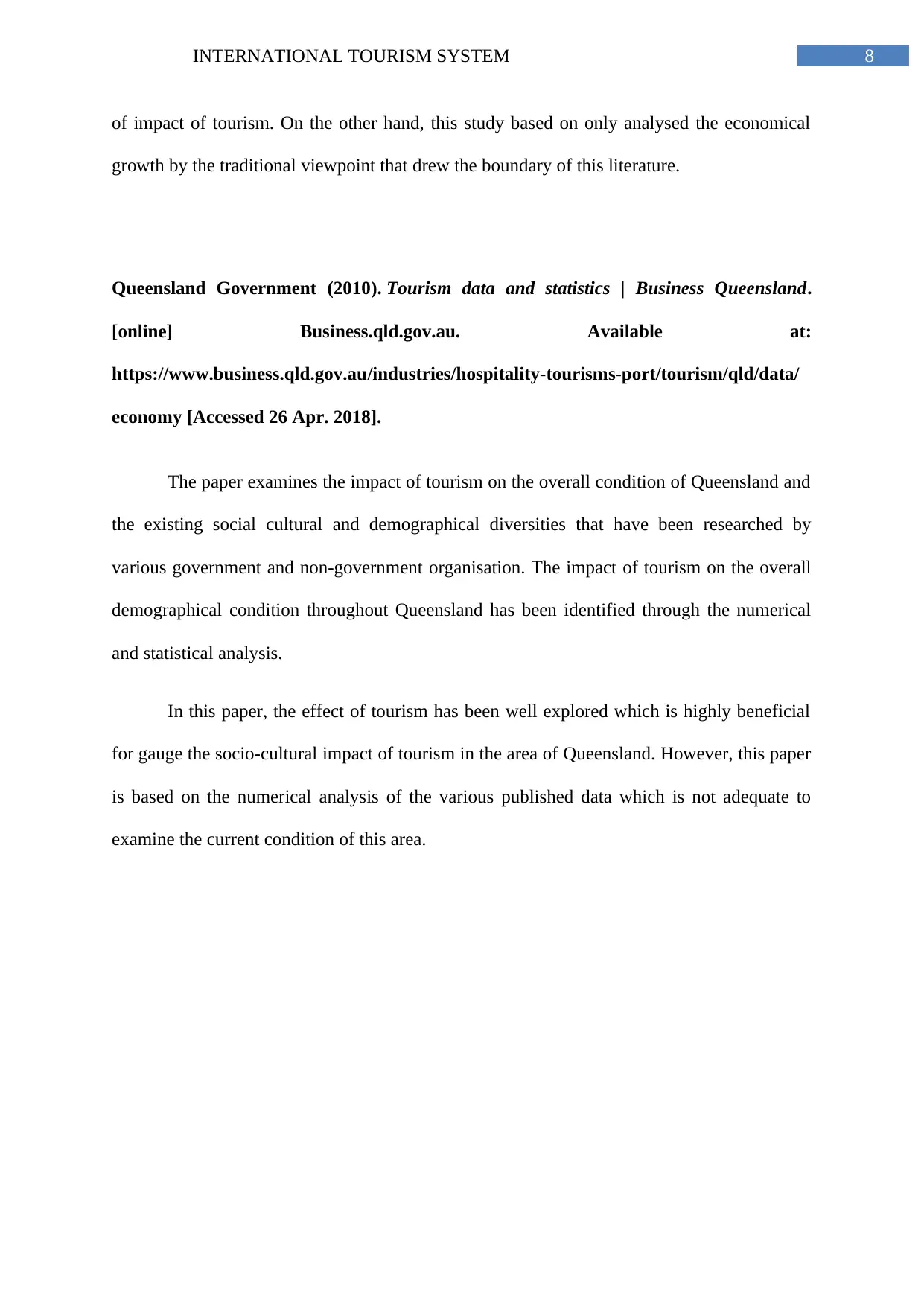
8INTERNATIONAL TOURISM SYSTEM
of impact of tourism. On the other hand, this study based on only analysed the economical
growth by the traditional viewpoint that drew the boundary of this literature.
Queensland Government (2010). Tourism data and statistics | Business Queensland.
[online] Business.qld.gov.au. Available at:
https://www.business.qld.gov.au/industries/hospitality-tourisms-port/tourism/qld/data/
economy [Accessed 26 Apr. 2018].
The paper examines the impact of tourism on the overall condition of Queensland and
the existing social cultural and demographical diversities that have been researched by
various government and non-government organisation. The impact of tourism on the overall
demographical condition throughout Queensland has been identified through the numerical
and statistical analysis.
In this paper, the effect of tourism has been well explored which is highly beneficial
for gauge the socio-cultural impact of tourism in the area of Queensland. However, this paper
is based on the numerical analysis of the various published data which is not adequate to
examine the current condition of this area.
of impact of tourism. On the other hand, this study based on only analysed the economical
growth by the traditional viewpoint that drew the boundary of this literature.
Queensland Government (2010). Tourism data and statistics | Business Queensland.
[online] Business.qld.gov.au. Available at:
https://www.business.qld.gov.au/industries/hospitality-tourisms-port/tourism/qld/data/
economy [Accessed 26 Apr. 2018].
The paper examines the impact of tourism on the overall condition of Queensland and
the existing social cultural and demographical diversities that have been researched by
various government and non-government organisation. The impact of tourism on the overall
demographical condition throughout Queensland has been identified through the numerical
and statistical analysis.
In this paper, the effect of tourism has been well explored which is highly beneficial
for gauge the socio-cultural impact of tourism in the area of Queensland. However, this paper
is based on the numerical analysis of the various published data which is not adequate to
examine the current condition of this area.
⊘ This is a preview!⊘
Do you want full access?
Subscribe today to unlock all pages.

Trusted by 1+ million students worldwide
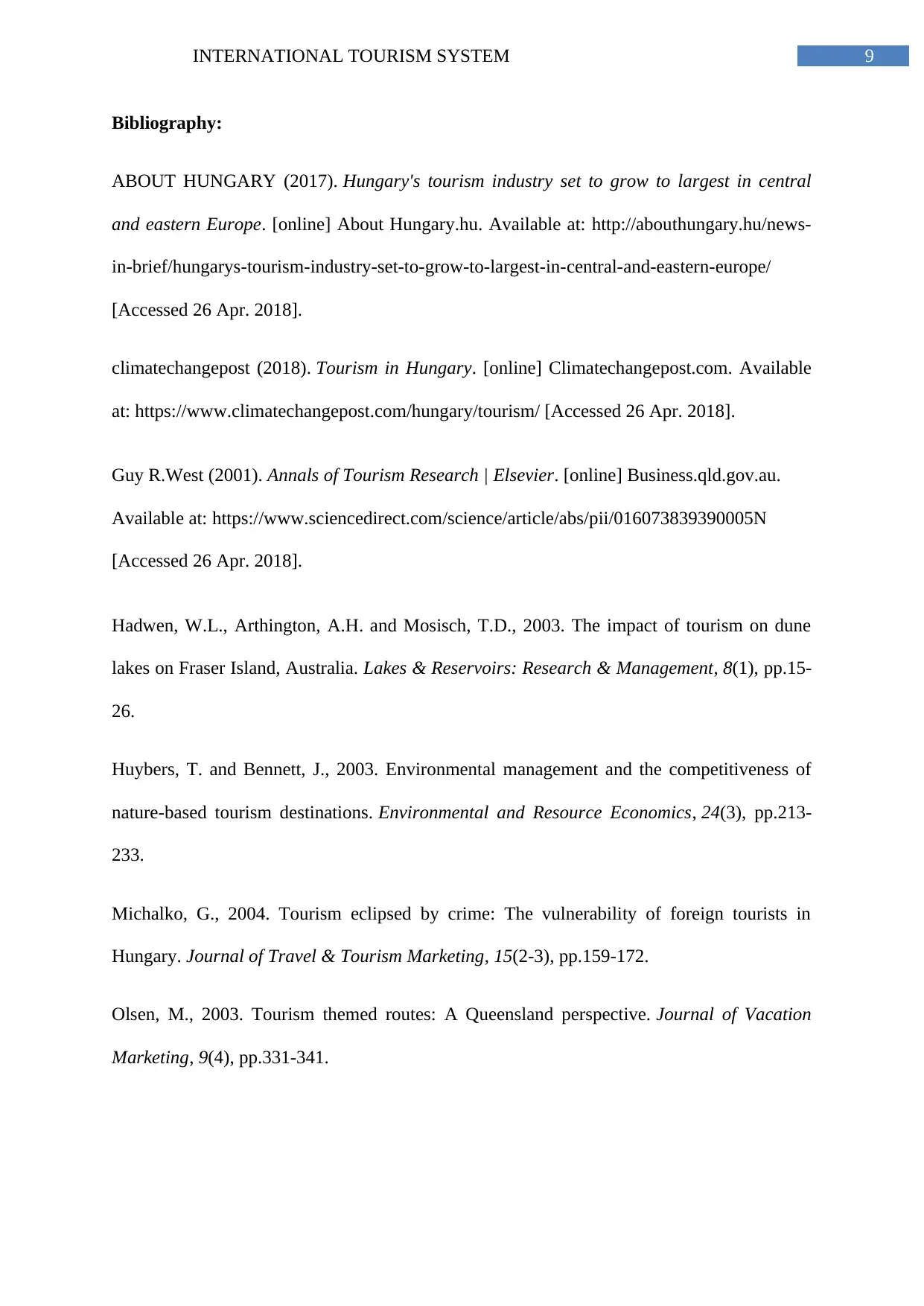
9INTERNATIONAL TOURISM SYSTEM
Bibliography:
ABOUT HUNGARY (2017). Hungary's tourism industry set to grow to largest in central
and eastern Europe. [online] About Hungary.hu. Available at: http://abouthungary.hu/news-
in-brief/hungarys-tourism-industry-set-to-grow-to-largest-in-central-and-eastern-europe/
[Accessed 26 Apr. 2018].
climatechangepost (2018). Tourism in Hungary. [online] Climatechangepost.com. Available
at: https://www.climatechangepost.com/hungary/tourism/ [Accessed 26 Apr. 2018].
Guy R.West (2001). Annals of Tourism Research | Elsevier. [online] Business.qld.gov.au.
Available at: https://www.sciencedirect.com/science/article/abs/pii/016073839390005N
[Accessed 26 Apr. 2018].
Hadwen, W.L., Arthington, A.H. and Mosisch, T.D., 2003. The impact of tourism on dune
lakes on Fraser Island, Australia. Lakes & Reservoirs: Research & Management, 8(1), pp.15-
26.
Huybers, T. and Bennett, J., 2003. Environmental management and the competitiveness of
nature-based tourism destinations. Environmental and Resource Economics, 24(3), pp.213-
233.
Michalko, G., 2004. Tourism eclipsed by crime: The vulnerability of foreign tourists in
Hungary. Journal of Travel & Tourism Marketing, 15(2-3), pp.159-172.
Olsen, M., 2003. Tourism themed routes: A Queensland perspective. Journal of Vacation
Marketing, 9(4), pp.331-341.
Bibliography:
ABOUT HUNGARY (2017). Hungary's tourism industry set to grow to largest in central
and eastern Europe. [online] About Hungary.hu. Available at: http://abouthungary.hu/news-
in-brief/hungarys-tourism-industry-set-to-grow-to-largest-in-central-and-eastern-europe/
[Accessed 26 Apr. 2018].
climatechangepost (2018). Tourism in Hungary. [online] Climatechangepost.com. Available
at: https://www.climatechangepost.com/hungary/tourism/ [Accessed 26 Apr. 2018].
Guy R.West (2001). Annals of Tourism Research | Elsevier. [online] Business.qld.gov.au.
Available at: https://www.sciencedirect.com/science/article/abs/pii/016073839390005N
[Accessed 26 Apr. 2018].
Hadwen, W.L., Arthington, A.H. and Mosisch, T.D., 2003. The impact of tourism on dune
lakes on Fraser Island, Australia. Lakes & Reservoirs: Research & Management, 8(1), pp.15-
26.
Huybers, T. and Bennett, J., 2003. Environmental management and the competitiveness of
nature-based tourism destinations. Environmental and Resource Economics, 24(3), pp.213-
233.
Michalko, G., 2004. Tourism eclipsed by crime: The vulnerability of foreign tourists in
Hungary. Journal of Travel & Tourism Marketing, 15(2-3), pp.159-172.
Olsen, M., 2003. Tourism themed routes: A Queensland perspective. Journal of Vacation
Marketing, 9(4), pp.331-341.
Paraphrase This Document
Need a fresh take? Get an instant paraphrase of this document with our AI Paraphraser
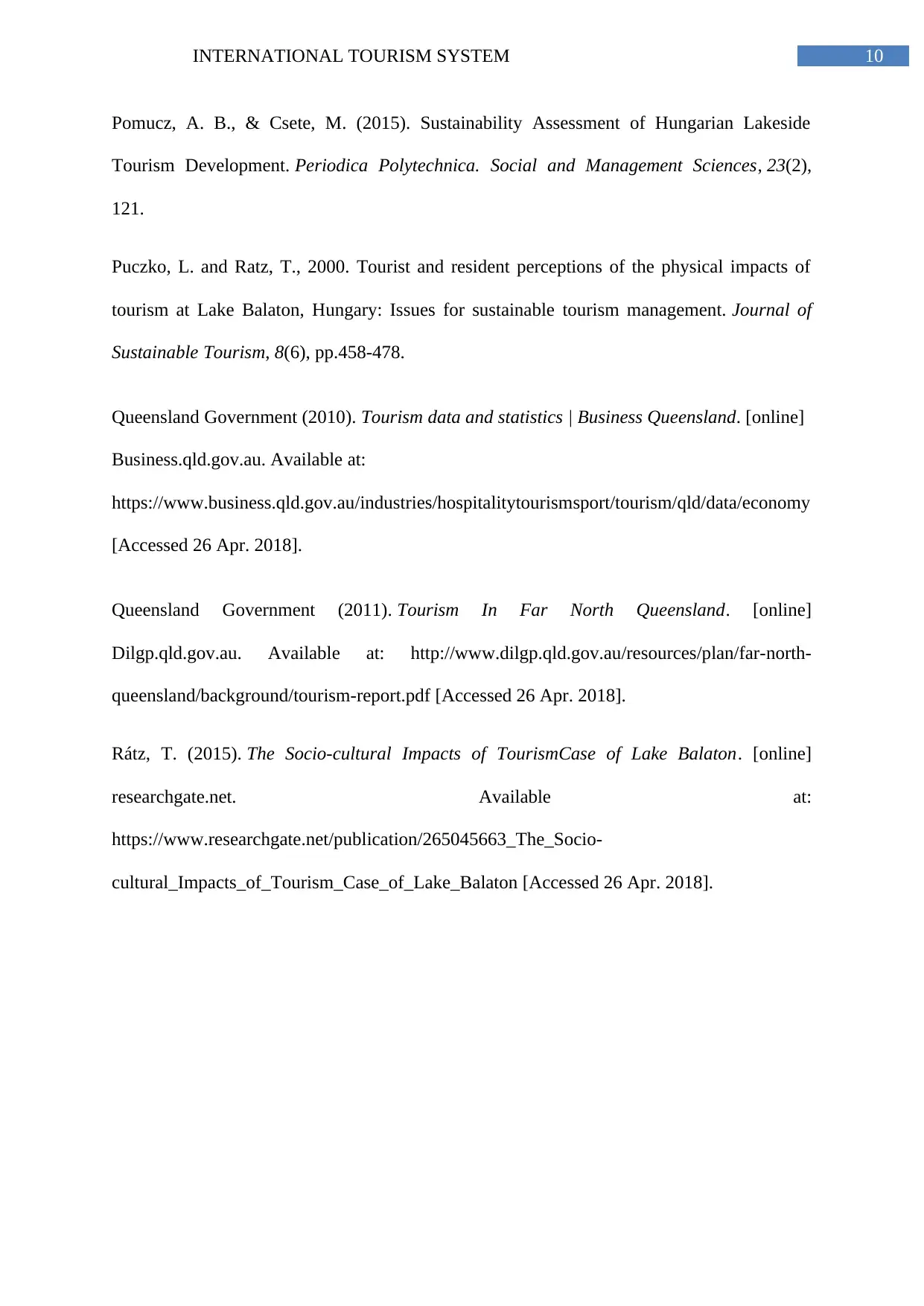
10INTERNATIONAL TOURISM SYSTEM
Pomucz, A. B., & Csete, M. (2015). Sustainability Assessment of Hungarian Lakeside
Tourism Development. Periodica Polytechnica. Social and Management Sciences, 23(2),
121.
Puczko, L. and Ratz, T., 2000. Tourist and resident perceptions of the physical impacts of
tourism at Lake Balaton, Hungary: Issues for sustainable tourism management. Journal of
Sustainable Tourism, 8(6), pp.458-478.
Queensland Government (2010). Tourism data and statistics | Business Queensland. [online]
Business.qld.gov.au. Available at:
https://www.business.qld.gov.au/industries/hospitalitytourismsport/tourism/qld/data/economy
[Accessed 26 Apr. 2018].
Queensland Government (2011). Tourism In Far North Queensland. [online]
Dilgp.qld.gov.au. Available at: http://www.dilgp.qld.gov.au/resources/plan/far-north-
queensland/background/tourism-report.pdf [Accessed 26 Apr. 2018].
Rátz, T. (2015). The Socio-cultural Impacts of TourismCase of Lake Balaton. [online]
researchgate.net. Available at:
https://www.researchgate.net/publication/265045663_The_Socio-
cultural_Impacts_of_Tourism_Case_of_Lake_Balaton [Accessed 26 Apr. 2018].
Pomucz, A. B., & Csete, M. (2015). Sustainability Assessment of Hungarian Lakeside
Tourism Development. Periodica Polytechnica. Social and Management Sciences, 23(2),
121.
Puczko, L. and Ratz, T., 2000. Tourist and resident perceptions of the physical impacts of
tourism at Lake Balaton, Hungary: Issues for sustainable tourism management. Journal of
Sustainable Tourism, 8(6), pp.458-478.
Queensland Government (2010). Tourism data and statistics | Business Queensland. [online]
Business.qld.gov.au. Available at:
https://www.business.qld.gov.au/industries/hospitalitytourismsport/tourism/qld/data/economy
[Accessed 26 Apr. 2018].
Queensland Government (2011). Tourism In Far North Queensland. [online]
Dilgp.qld.gov.au. Available at: http://www.dilgp.qld.gov.au/resources/plan/far-north-
queensland/background/tourism-report.pdf [Accessed 26 Apr. 2018].
Rátz, T. (2015). The Socio-cultural Impacts of TourismCase of Lake Balaton. [online]
researchgate.net. Available at:
https://www.researchgate.net/publication/265045663_The_Socio-
cultural_Impacts_of_Tourism_Case_of_Lake_Balaton [Accessed 26 Apr. 2018].
1 out of 11
Your All-in-One AI-Powered Toolkit for Academic Success.
+13062052269
info@desklib.com
Available 24*7 on WhatsApp / Email
![[object Object]](/_next/static/media/star-bottom.7253800d.svg)
Unlock your academic potential
Copyright © 2020–2025 A2Z Services. All Rights Reserved. Developed and managed by ZUCOL.


